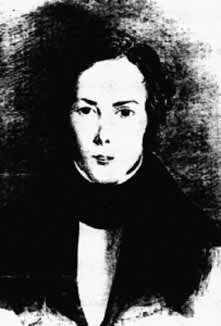John T. Graves facts for kids
John Thomas Graves (born December 4, 1806 – died March 29, 1870) was a smart Irish person who studied both law and math. He was a good friend of another famous mathematician, William Rowan Hamilton. John Graves actually helped inspire Hamilton to discover something called quaternions in 1843. Later that same year, Graves himself discovered a new kind of math called octonions, which he called "octaves." His brother, Charles Graves, was also a mathematician and a bishop.
Contents
Life Story of John Graves
John Thomas Graves was born in Dublin, Ireland, on December 4, 1806. His father, John Crosbie Graves, was a lawyer. John went to school in England, near Bristol.
Education and Early Career
Graves went to Trinity College, Dublin, where he was very good at both science and classic subjects. He was classmates and friends with William Rowan Hamilton. John graduated in 1827. After that, he went to Oriel College in Oxford.
In 1831, Graves became a lawyer in England. He worked for a short time in the western part of the country. In 1839, he became a professor of law at London University College. Soon after, he also became an examiner for law students at the University of London.
Important Groups and Work
John Graves was part of several important groups. He was on a committee for the Society for the Diffusion of Useful Knowledge, which helped spread information. In 1839, he became a Fellow of the Royal Society, which is a very old and respected science group. He was also a member of the Philological Society (which studies language) and the Royal Society of Literature (which studies writing).
In 1846, Graves started working as an assistant poor-law commissioner. This meant he helped manage laws that supported poor people in England and Wales.
John Graves married Amelia Tooke in 1846. He passed away on March 29, 1870, in Cheltenham, England. He did not have any children.
John Graves's Math Discoveries
When John Graves was only 20 years old (in 1826), he started studying complex math ideas like exponential functions and complex logarithms. His findings were published in a science paper in 1829. At first, some other mathematicians, like George Peacock and Sir John Herschel, didn't agree with his ideas. But Graves kept explaining his discoveries.
Working with William Rowan Hamilton
In 1834, William Rowan Hamilton wrote a paper that supported Graves's work. Hamilton said that thinking about Graves's ideas on "imaginary logarithms" helped him develop his own math theories. This work eventually led Hamilton to discover quaternions.
Graves and Hamilton wrote many letters to each other about these complex math ideas. In 1843, Hamilton finally discovered quaternions. He told Graves about this discovery right away, on October 17, 1843. Hamilton later said that Graves's ideas and encouragement were very important to his own discoveries.
Discovering Octonions
Right after Hamilton discovered quaternions, before the end of 1843, Graves made his own big discovery. He found a way to extend a math rule (called Euler's four-square identity) to eight squares. He then created a new math system called "octaves," which we now call octonions. These octonions were similar to Hamilton's quaternions but had even more parts. They are still studied today in advanced physics, like in the Standard Model of particle physics.
Graves also worked on other math ideas, sometimes with his brother Charles. He also encouraged Hamilton to study shapes with many sides, called polyhedra.
John Graves as a Legal Expert
Besides math, John Graves was also an expert in law. He gave twelve lectures on international law, which were written down in a legal newspaper starting in 1845. He also wrote two detailed articles about Roman law and canon law (church law) for a large encyclopedia.
He also wrote about famous legal thinkers for a dictionary of Greek and Roman history. These included articles on people like Gaius and the laws of Justinian.
John Graves's Legacy
For many years, John Graves collected math books. He had a huge collection of over ten thousand books and about five thousand smaller papers. When he died, he gave all these valuable math materials to University College London.


